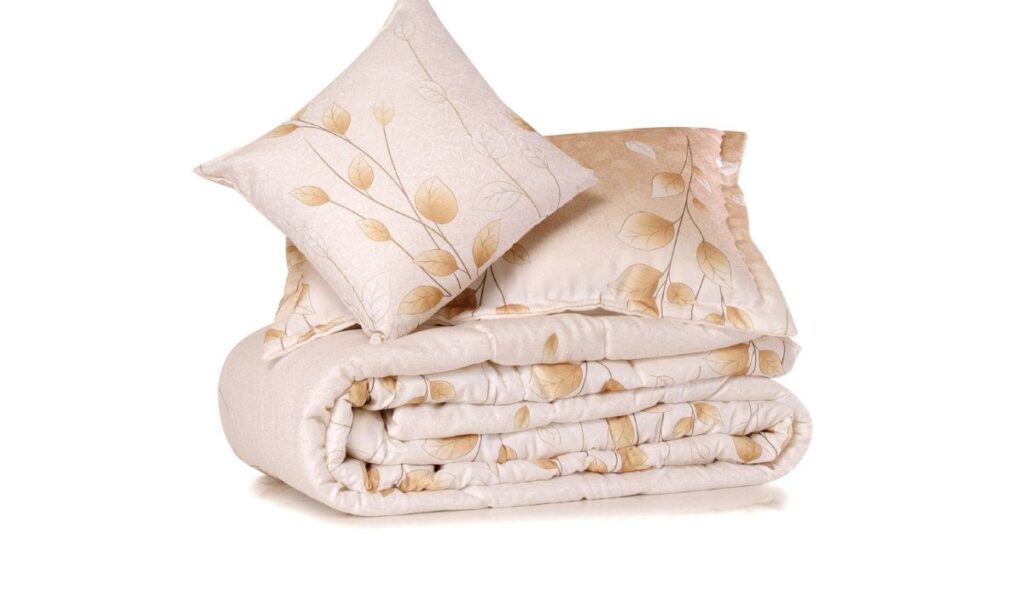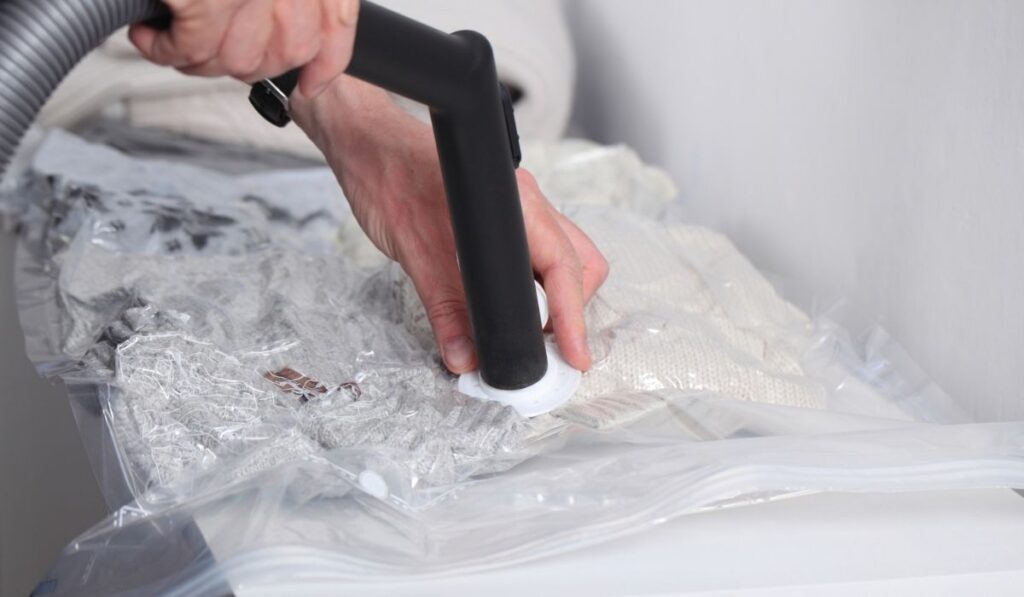At certain times of the year, it may be necessary to pack away your cozy comforter or duvet. It might be in those warm summer months or to save space until your next guest arrives. Whatever the reason, storing away a bulky comforter can be tough. A good option is to vacuum pack it into plastic storage bags. But is that safe for the comforter?
Vacuum packing a synthetic (hollow fiber-filled) comforter is safe as long as you’ve got a durable bag that is large enough for the job. Down-filled comforters, however, could be damaged by vacuum packing and instead should be kept in a breathable linen bag.
While vacuum packing comforters are a common practice and generally ok for some types, there are a few alternative storage methods you can also consider. You’ll find a few of these options towards the end of this article. But before we get there, let’s take a quick look at comforters and which types can be vacuum sealed.
What Is a Comforter?

A comforter is essentially a large pouch of fabric filled with cotton, polyester, wool, silk, or other soft fibers. Frequently, comforters are flat and not as fluffy as a duvet, the European equivalent.
The fillings for duvets are typically down, while comforters can have a variety of fillings. You may find some comforters filled with down or a down alternative, but such duvets tend to have less filling than regular duvets. Some comforters are quilted to ensure their filling is kept intact.
Comforters and bedspreads can serve as ornamental pieces, although bedspreads are generally thinner and not designed for sleeping. Comforters, on the other hand, are thinner than duvets, but you can still enjoy some warmth and protection during the night when you use comforters.
There are several advantages to using a comforter. Comforters are relatively affordable and easily maintained. If you’re looking for a certain look to match your decor, you can get them in a wide variety of colors and patterns.
What Is Thread Count?
One of the most important things to consider when choosing a comforter is the material’s thread count. The thread count refers to the number of threads found within each square inch of the material.
The thread count applies only to the comforter’s shell and is reflective of the durability and texture of the comforter. You should know that a higher thread count doesn’t necessarily translate to better quality.
You may find a thread count of 800 on a comforter, but if these threads are shorter and thinner, your bedding’s durability will be nil.
The best option is always comforters with fabrics boasting 300 to 500 thread count. Pay close attention to the weave, too; if it’s strong and durable, then the comforter is bound to be durable but also breathable. One good example of a strong and durable weave is the percale weave.
Cotton, polyester, silk, or a blend of fabrics are some of the different materials that can be used to form the comforter’s shell.
Oftentimes, natural materials like cotton are best suited for the cover. Their soft and breathable nature makes them the best option. When synthetic fibers are used in producing a shell, it retains heat and doesn’t keep moisture off the body as cotton does.
What Goes Inside a Comforter?
There are three kinds of fillings you’ll likely find in a regular comforter. The cheapest of these is the hollow-fiber synthetic filler. The hollow-fiber synthetic filler is an artificial material made up of hollow fiber strands which help to keep air trapped.
The more expensive options are fillers made from duck feathers and down. This is considered a more effective filling considering it contains fine down layers and the aforementioned feathers.
Most comforter fillings are either wool, cotton, or a poly-blend that feels just like down (a down alternative). If you desire the soft texture of down at a less costly price, then go for down alternative comforters.
This makes for an even better option when you learn that real down can trigger nasal congestion and activate allergic reactions in some people.
Can You Vacuum Seal a Comforter?

One perfect storage option for your cotton or polyester comforter is a large vacuum-seal bag (on Amazon). You’re advised to only vacuum pack comforters that are hollow fiber-filled because goose-down fillings can be damaged.
Be sure to store it in the bag after it’s been fully cleaned and dried. To retain that extra freshness, add a dryer sheet to the bag.
If you plan to vacuum pack your comforter, the first thing you need is a plastic storage bag that’s big enough to do the job.
Don’t store your down comforter in a plastic bag if you hope to avoid mildew and mold. But it’s okay to keep these comforters in a plastic bag or possibly vacuum seal them when you have no other alternatives.
One other common concern when it comes to storing comforters is insects, so the ideal storage position for your bedding is the armoire or linen closet.
Other Tips for Storing Your Comforter
There are specific techniques to ensure your comforter stays fresh and fluffy for many years, regardless of whether you vacuum pack it or choose another storage method. You shouldn’t just fold it up and stick it in the back of the closet, or it may deteriorate.
We’ve outlined four essential steps to ensure the longevity of your comforter below:
1. Give Your Comforter a Good Wash
It is vital that you clean your comforter before storing but only if it is dirty. Too much washing can harm the filling of your comforter, especially if yours has a down filling.
You can get a professional to clean your down comforter if you want to make sure no damage is done to the comforter.
If your comforter’s filling is made with a down alternative, you may attempt to wash it at home. All you have to do is ensure you follow the necessary instructions religiously.
2. Don’t Pack a Wet Comforter
The first step is to clean your comforter, and the second is to make sure the comforter is dry before you store it. If you store a comforter when it’s not fully dry, it will likely develop mold or mildew.
Whether you get professional help or clean your comforter at home, take a moment a feel carefully around the comforter to ensure there are no wet spots left. If you stumble upon any wet areas, do not store the comforter; leave it to dry thoroughly.
If your comforter has a down filling, don’t air-dry it. Air-drying a down comforter can cause mold or mildew to form. Comforters with alternative down fillings, however, can be air-dried.
3. Place Your comforter in a Breathable Bag
If you want to protect your comforter from dirt and bugs, get a breathable linen bag like this one from Polecasa (on Amazon). This bag will keep bugs away from your comforter while at the same time allowing a good amount of air to get through.
The airflow prevents mold and mildew from forming. If you can’t get a linen bag, a linen sheet can serve as a good alternative.
Please don’t put your down comforter in a plastic bag because it may lead to the formation of mold or mildew.
If you own an alternative down comforter, you can safely store this in a plastic bag or vacuum seal it.
4. Keep Your Comforter in a Cool, Dry place
After wrapping your comforter in a linen bag, place it in an excellent dry spot. Storing it in a humid place will make your comforter soak up humidity, which may cause mold or mildew to form.
Don’t just leave your comforter on the floor, which may attract insects. Place your comforter in an armoire or a linen closet; they are the best spots for storage.
Don’t place any other thing on top of your comforter. Placing other objects on your comforter can destroy the filling and cause all the fluffiness to deteriorate. If you have to store your comforter with other items, ensure the comforter is placed on top.
